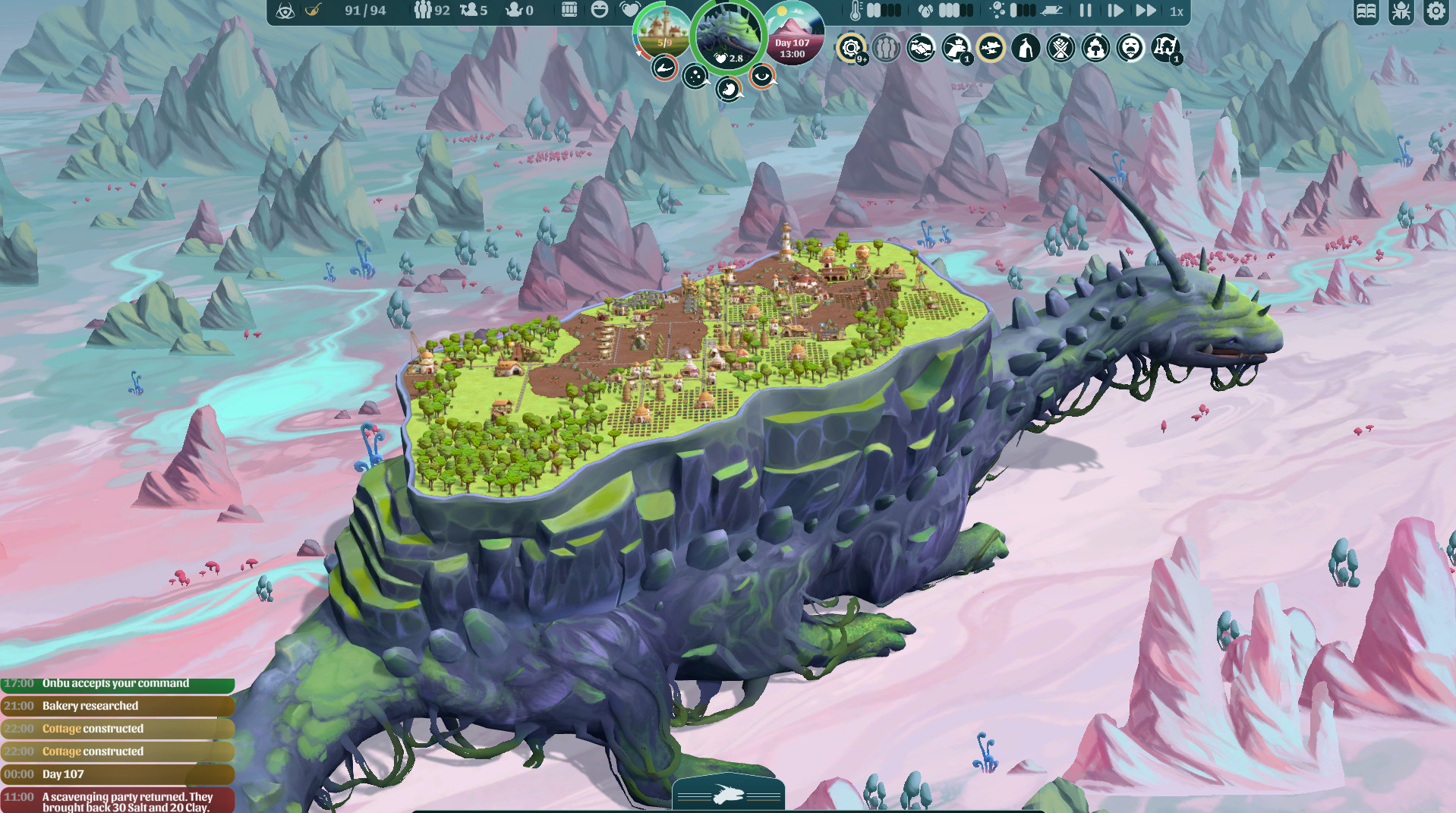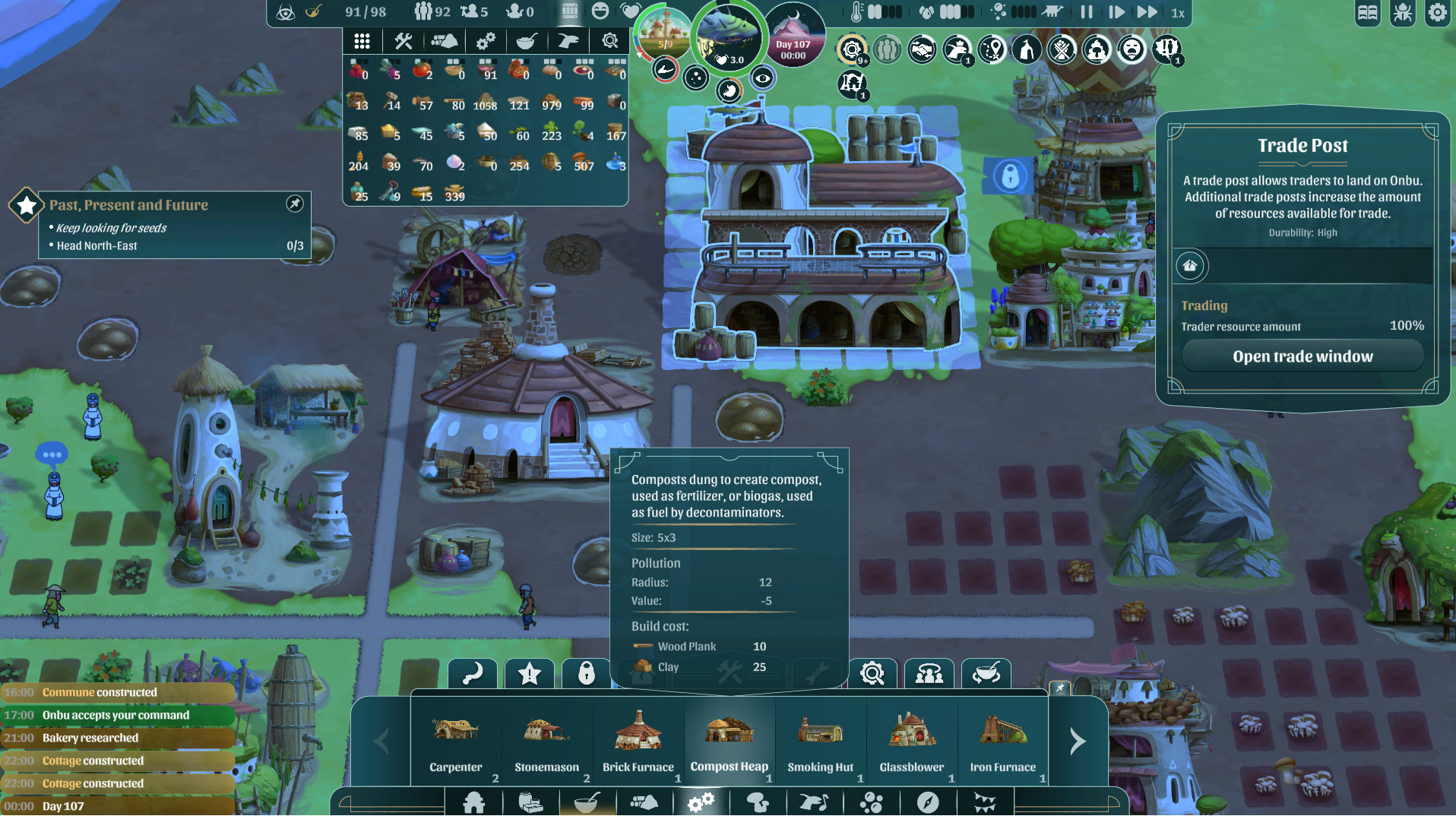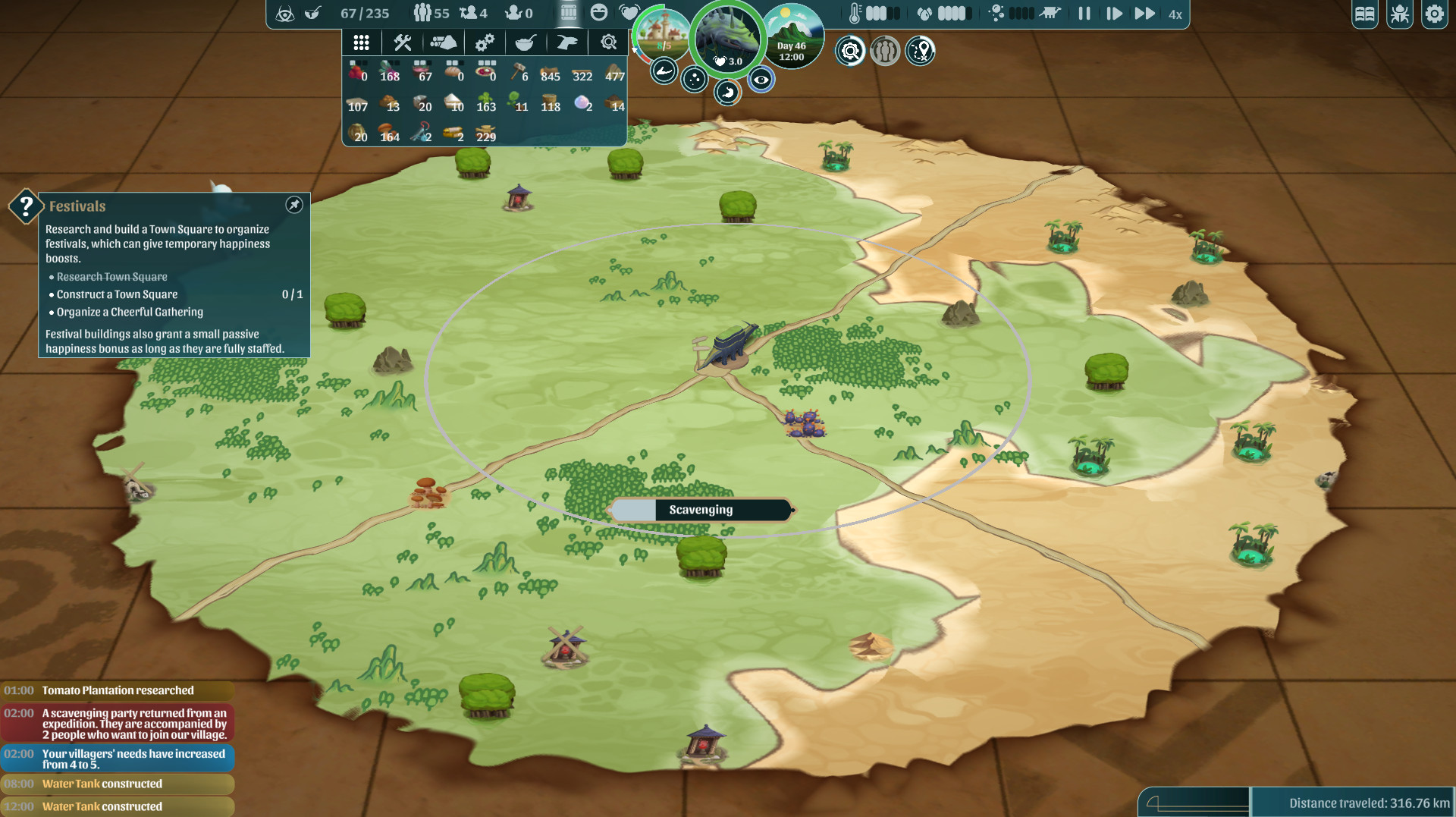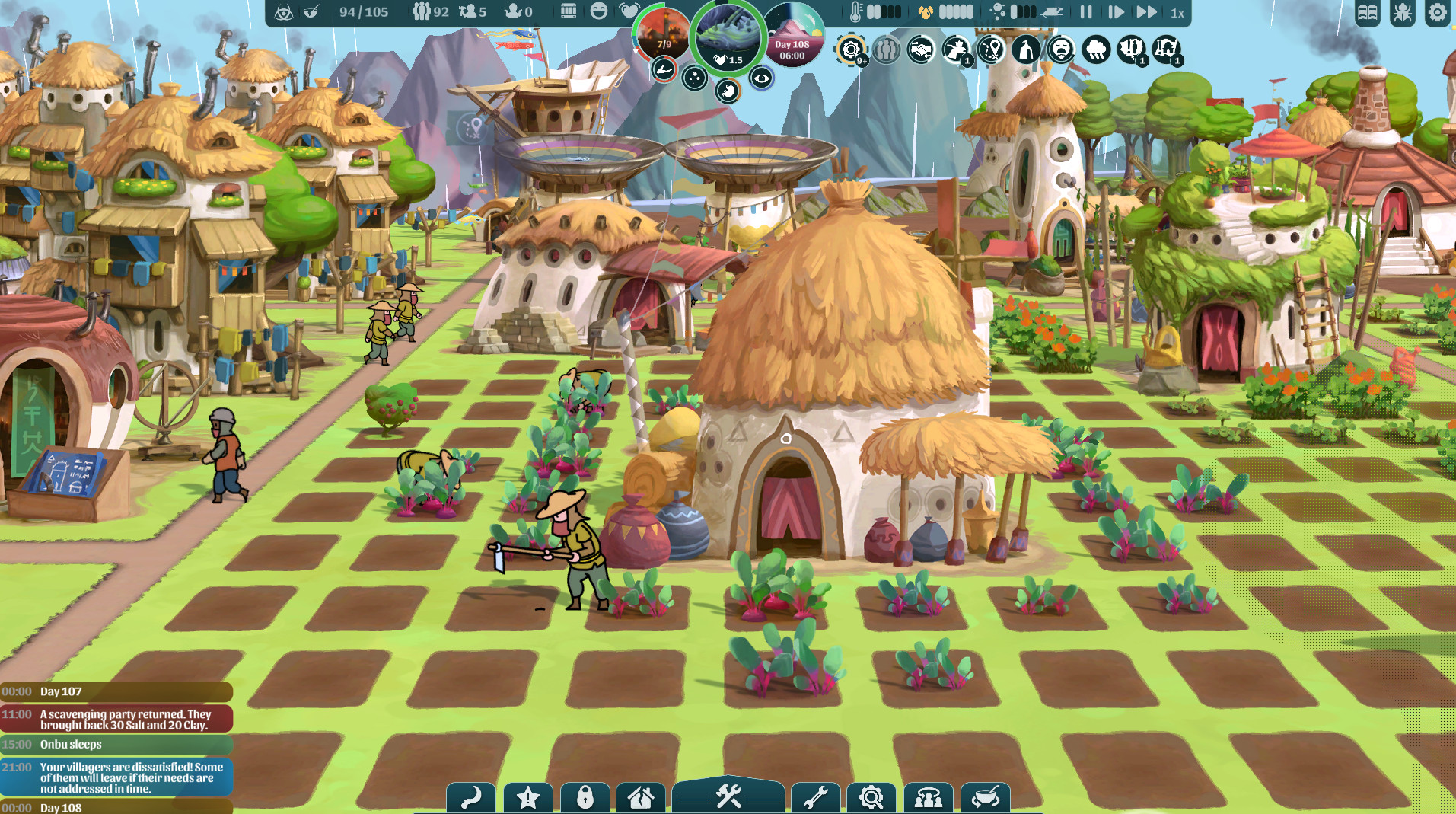Platforms:
Xbox One, PS4, PC, Nintendo Switch, PS5
Released:
July 18, 2025
Publishers:
Stray Fawn Publishing, WhisperGames
Developer:
Stray Fawn Publishing
To me, the beating heart of any city-builder / simulation game is the poetic balance of aesthetic design and mechanical optimisation. It’s how successfully the game lets you create a visual paradise while scratching that itch, telling you that what you’ve made is pretty good, buuuuuuut… if you tweaked the layout and placed some better roads, or redesigned the work schedule and resource distribution, it could be OPTIMAL. MORE EFFICIENT. GLORIOUS MECHANICAL PERFECTI-
…Ahem, that is to say, it could always be better. The Wandering Village decided the obvious choice to optimise the city-builder genre was by adding Ondu, giant dinosaur-like creatures that roam the lands. And adding dinosaurs is a genius move in any game if you ask me.
Just as importantly, The Wandering Village hits the fundamentals of the city-builder genre well, and with visual flair to boot. It certainly has the satisfaction of research progression, managing the needs of your villagers, and debating whether to care for the majestic beast upon whose back you rest your weary bodies or to carve every scrap of production from the giant who bears you onward. However, while the Wandering Village is a feast for the eyes and ears, it runs into limitations on a few fronts that leave it never quite hitting the machine-precise designing that I crave.
But firstly, let’s just take a moment to agree that The Wandering Village is visually gorgeous.

The vibrant colour palette that washes every scene in verdant splendour (even in the midst of toxic fumes), the majesty of the Ondu’s scale as it strides colossal through the myriad biomes of the world, the crisp lines and glossy paper-cutout sprites of your villagers and their vibrant homes, every aspect of The Wandering Village is visual splendour… except when it comes to the UI, which is at best a little unintuitive, and at worst, heinously cluttered.

It can frequently be difficult to parse what you’re looking at as you pick through different resources or societal displays, and the granular management details you might be hoping to monitor in a simulation game are either buried or not present, even if the information must be somewhere in the game engine itself. Early in the tutorial, at least a third of my screen was covered in pinned tutorial tasks that, along with unintuitive menu labelling, made learning how everything worked a bit of a headache. Unpinning the tasks doesn’t necessarily help either, as story progression seems to require the tasks to be pinned, or you won’t be prompted with the dialogue to carry on and will have to go in and pin it again to allow you to activate the next scene. And while the art-style for villagers and buildings is both strikingly beautiful and a clever way to make use of sprites rather than 3D models, it has limitations.
The inability to rotate your buildings is one such barrier that, in a game system that uses grid-based settlement planning, isn’t just a restriction on the aesthetic design of your village, but can present an active, significant layout (and therefore gameplay) constraint. Obviously, it’s not a game-breaking limitation, but more than a few times, I found myself blocked by the smallest overlap in building or resource placement that, if I had the ability to align my sawmill vertically rather than horizontally, for example, I’d be able to make things just the way I wanted them. These limitations and UI frustrations are fairly minor complaints, but they nagged at me often enough while playing that I could never fully forget about them. Unfortunately, the gorgeous sprite-based art style isn’t the only thing that’s 2-dimensional in The Wandering Village.

Despite the aforementioned UI troubles, The Wandering Village is quite an easy game to learn, especially as city-builders go. The resource variety is fairly modest, their acquisition is largely intuitive, the needs of your villagers are identifiable both in demand and supply, and the research progression tree is laid out cleanly and sensibly. Unfortunately, it feels like the low skill-floor it takes to get into The Wandering Village is matched by quite a low skill-ceiling, which isn’t really mitigated by the addition of optional Challenge runs. It feels like there’s absolutely an optimal way to design your village and manage resources, and it’s easy to find and simple to implement.
The design of a good city (both real and in fiction) is traditionally defined by a restriction or detail, most often that of a significant geographical feature (Like the Hudson River in New York or the canals of Venice). In this case, the village is atop an enormous creature that travels through different climates, weather conditions and altitudes. As a result, designing your village to thrive is a matter of conforming to the natural features of the Ondu while building adaptably to meet diverse climate restricti- Oh wait, no. The Ondu has a huge flat zone on its back which is the only place you can (or would ever need to) build on, improved versions of basic buildings will nullify almost all climate-based restrictions, and there are very few strategic choices to make in preparing for and dealing with weather, morale, or even the path your Ondu takes. When it comes to fitting your Ondu with a village, one size pretty much fits all.

Even if you want to get more specific with a challenge (let’s say you want a challenge where you’re always in a desert biome, for example), just always grow cacti and tomatoes, and research higher-tier houses like you’d do anyway. Challenge solved. Each possible challenge has pretty much one solution, and most of them aren’t exclusionary, meaning your village can weather any storm with little thought required. Even when it comes to your relationship with the Ondu itself, the choice to be kind and trust-building vs. cruel and exploitative doesn’t come with any meaningful trade-offs that you can’t easily nullify.
Hell, you can even turn your village into an Ondu-worshipping cult by trebucheting villagers into its maw, and it has no impact other than your villagers asking you to do it again every now and then in exchange for not rioting. Alternative to human sacrifice, build some hedges and they’ll love you forever. The Wandering Village is fun the first time through, but the challenges are few, optimisation is unnecessary and basically unsupported, and there’s no real reason to play through more than once. A giant dinosaur can bring me in, but it just can’t make me stay in this case.
7
Good
Positive:
- A solid grasp of city-builder fundamentals
- Charming audio and visual design
- Giant, loveable dinosaurs
Negative:
- The core premise (building atop a colossal beast) feels mechanically underutilized / irrelevant
- Challenge modes don't offer much in the way of replayability
- A lack of depth & complexity to its core systems
The Wandering Village has a grasp of the building blocks of its genre, but never truly capitalises on its core mechanics or its premise. Rather, it presents an enjoyable but somewhat shallow city-builder that just happens to also be on top of a wandering behemoth, rather than truly embracing and exploring what that could mean in gameplay terms. While its visuals and audio are both lovely, there is little here to really sink your teeth into, particularly for a veteran of the genre. The Wandering Village is worth a visit, but I wouldn’t want to live there.





